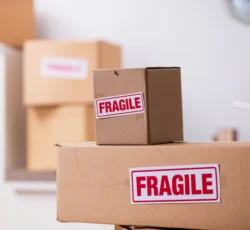How to Safely Transport Fragile Items During a Move
 Moving can be a stressful and challenging process, especially when it comes to packing and transporting fragile items. Whether it’s delicate glassware, valuable artwork, or sentimental family heirlooms, ensuring their safe arrival at your new location is of utmost importance. In this blog post, we will explore some essential tips and techniques to help you safely transport your fragile items during a move.
Moving can be a stressful and challenging process, especially when it comes to packing and transporting fragile items. Whether it’s delicate glassware, valuable artwork, or sentimental family heirlooms, ensuring their safe arrival at your new location is of utmost importance. In this blog post, we will explore some essential tips and techniques to help you safely transport your fragile items during a move.
1. Gather the necessary supplies:
Before you start packing, make sure you have all the necessary supplies to protect your fragile items. Some must-have packing materials include:
– Sturdy boxes: Invest in high-quality boxes that are the right size for your items. Avoid using old or worn-out boxes, as they may not provide adequate protection.
– Bubble wrap: Wrap fragile items individually in bubble wrap to cushion them from impact during transportation.
– Packing paper: Use packing paper to fill empty spaces in boxes and provide extra padding.
– Foam peanuts or air-filled packing bags: These materials can be used to fill gaps between items and prevent them from shifting during transportation.
– Tape and markers: Secure boxes with strong packing tape and label them clearly as “Fragile” to ensure careful handling.
2. Properly wrap each item:
When packing fragile items, it’s crucial to wrap each item individually to prevent them from bumping against each other. Start by placing a layer of packaging paper or bubble wrap at the bottom of the box for added protection. Then, individually wrap each item in several layers of bubble wrap, paying extra attention to corners and fragile parts. Secure the wrap with tape to keep it in place.
3. Use appropriate box sizes:
Using the right-sized boxes is essential to ensure the safe transportation of fragile items. Small or medium-sized boxes are ideal for heavier items like ceramics or glassware. However, larger and sturdier boxes should be used for larger, lighter items such as artwork or mirrors. Make sure there is enough space around the item for padding material and avoid overpacking the boxes to prevent them from becoming too heavy or overloaded.
4. Provide extra cushioning:
To protect fragile items from impact, it’s important to provide ample cushioning inside the box. Fill any empty space with crumpled packing paper or foam peanuts to prevent items from shifting during transportation. This additional cushioning will absorb shocks and minimize the risk of breakage.
5. Label boxes as “Fragile” and provide instructions:
Clearly label boxes containing fragile items as “Fragile.” This will alert movers or anyone handling the boxes to exercise extra caution. Additionally, you can mark boxes with arrows indicating the correct orientation of the items. For example, if certain items should always be kept upright, clearly label the box accordingly.
6. Consider professional help for valuable or delicate items:
When it comes to extremely valuable or delicate items, it may be wise to seek professional help. Specialty moving companies have experience and expertise in handling fragile items and will provide custom packaging solutions. They may also offer insurance options to protect your valuable items during transportation.
7. Take pictures for documentation:
Before packing fragile items, take photographs of each item. This serves as documentation and can be helpful in case any damage occurs during the move. Be sure to focus on any pre-existing damage, which can help differentiate between old and new damage.
8. Plan for the placement in the moving truck:
Consider the placement of fragile boxes in the moving truck. Place heavier boxes on the bottom and stack lighter boxes on top to prevent crushing. Ensure that fragile boxes are not placed under heavy furniture or items that may shift during transit.
9. Communicate and coordinate with movers:
If you’ve hired professional movers, it’s essential to communicate your specific requirements and concerns regarding fragile items. Clearly explain the nature of the items you need to transport, and ensure the movers are aware of their fragility. Discuss any additional instructions or precautions with them to minimize potential damage during the move.
Conclusion
Moving fragile items requires careful planning and attention to detail. By using the appropriate packing materials, providing extra cushioning, and properly labelling boxes, you can ensure the safe transport of your fragile items during a move. Communicating with movers and considering professional help for valuable items can offer added peace of mind. With these tips in mind, you can minimize the risk of damage and make your moving process a smoother and more secure experience.
Got Questions? Let Us Help!
Established in 2004, Delmarva Moving & Transport is a moving company located in Stevensville, Maryland. We provide moving services to all of Maryland, Delaware, Pennsylvania, New Jersey, Washington DC, West Virginia, Virginia, and some parts of North Carolina. Our team specializes in moving residential, small businesses, apartments, and seniors, along with big items like safes and pianos. Contact us today and we can provide a detailed estimate, moving planners, checklists, packing supplies, and more!
